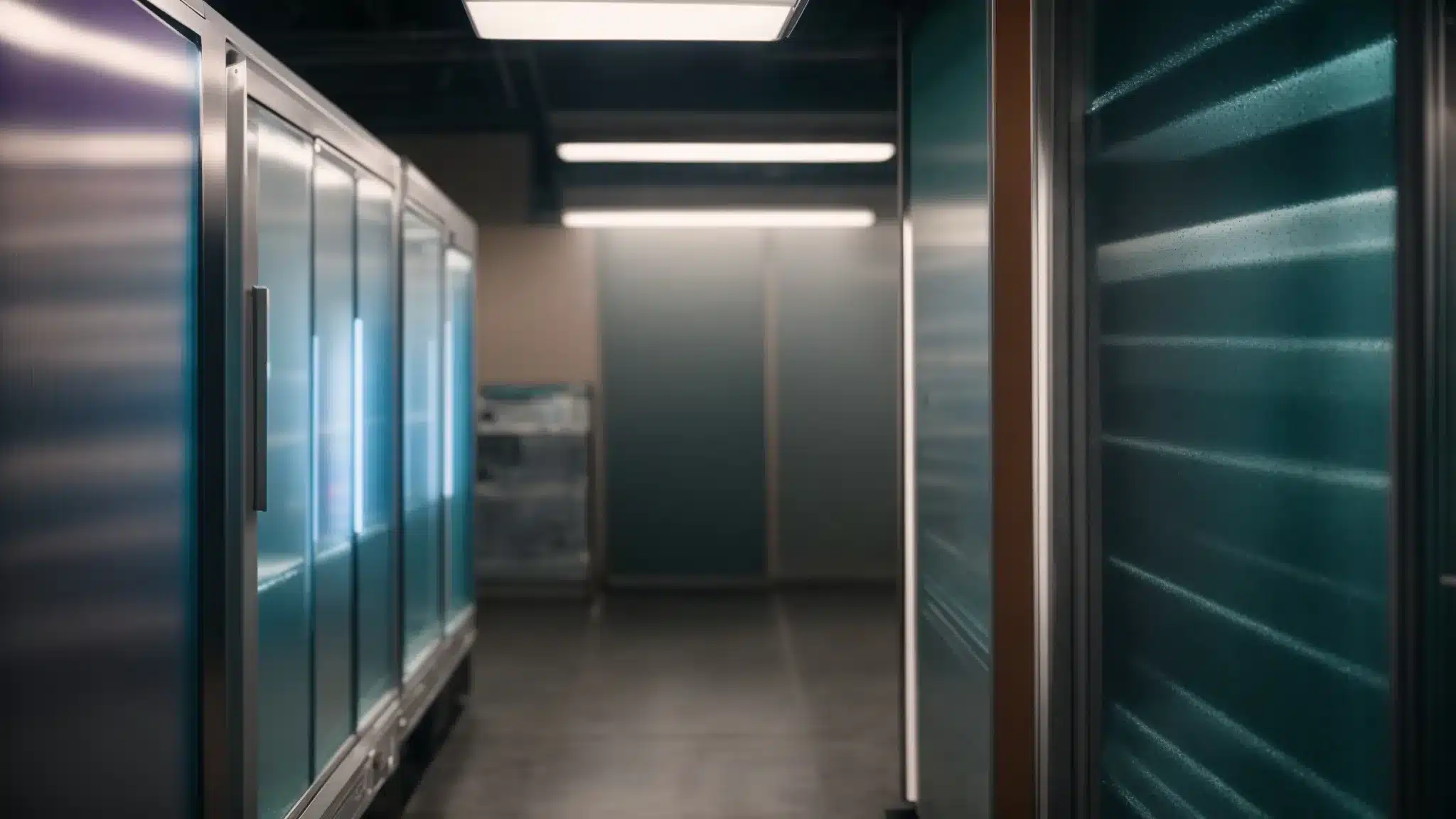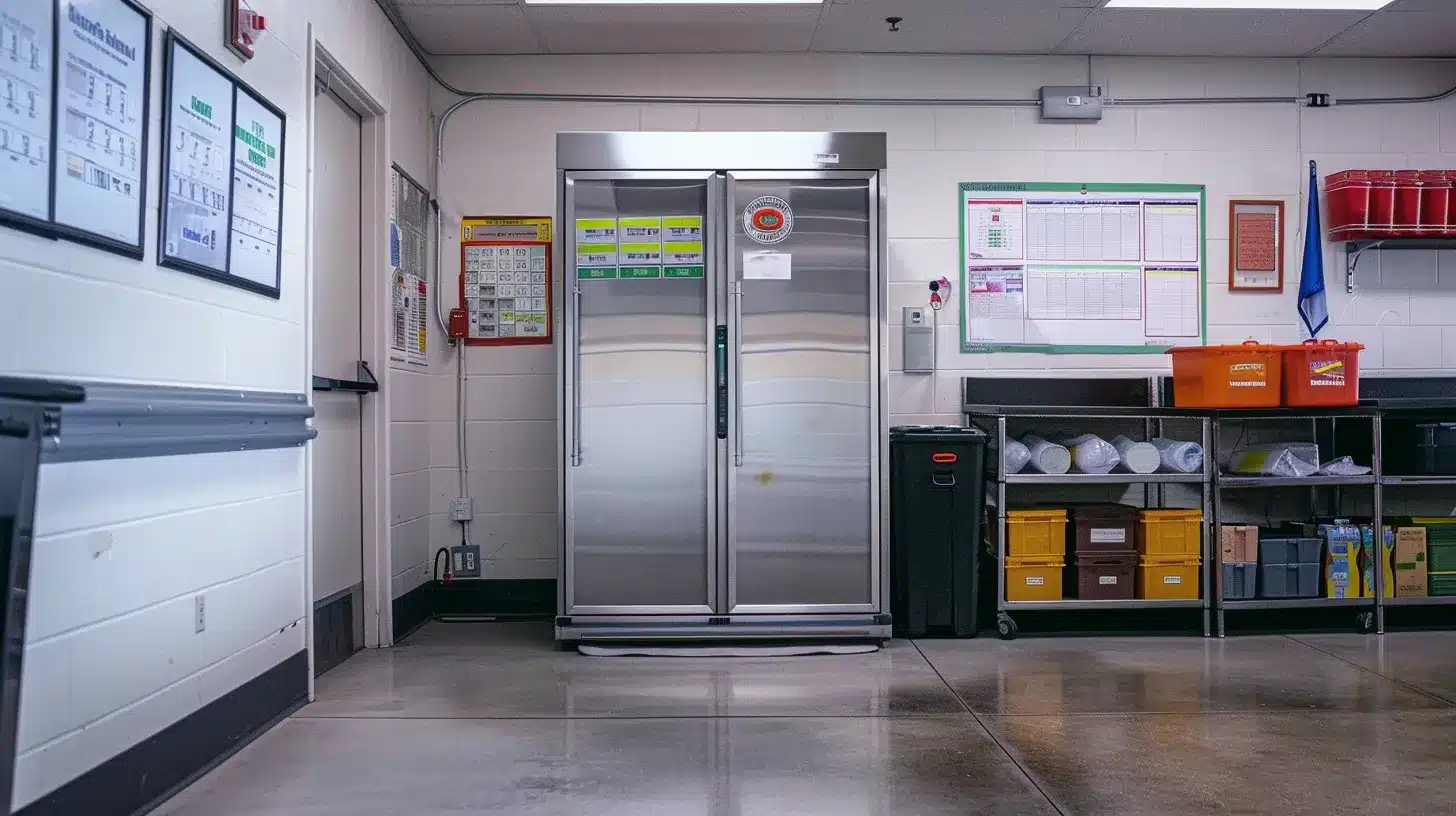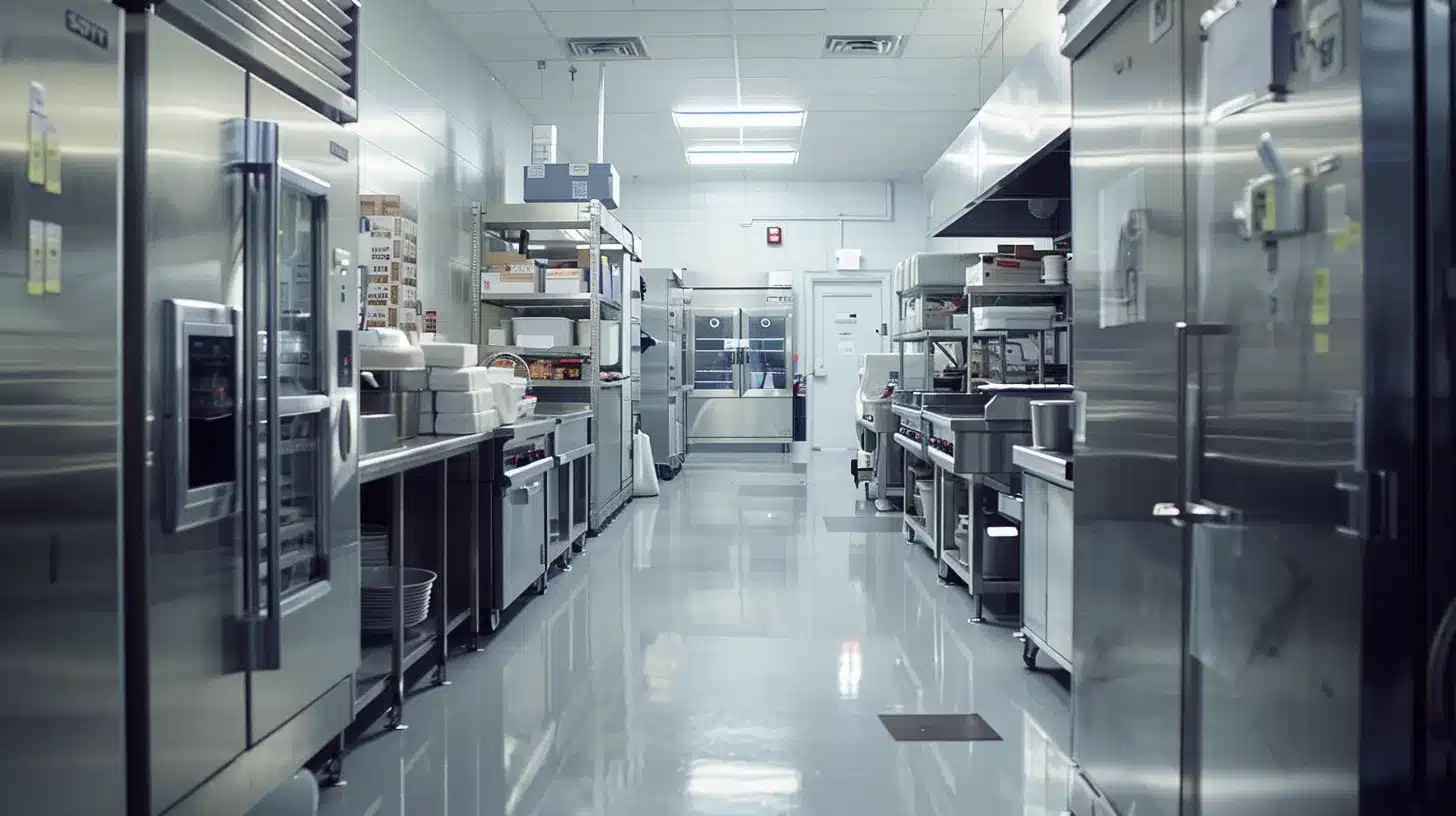Is your walk-in cooler struggling to maintain the right temperature? This issue can lead to spoiled inventory and lost profits. In this post, readers will learn about five key signs that indicate their walk-in cooler may need repair, including issues related to airflow and electrical malfunctions. Understanding these warning signals can prevent costly disruptions in a business, especially for those managing food and beverage services. This guide will help identify potential problems before they escalate and ensure compliance with health regulations. For more detailed information on maintaining your cooling systems, please visit Ohio refrigeration.
Key Takeaways
- Regular inspections help identify issues early, preventing costly repairs in walk-in coolers
- Employees should recognize warning signs to ensure prompt maintenance of refrigeration systems
- Proper cleaning and maintenance of components are essential for efficient cooler operation
- Compliance with health codes is crucial for safeguarding perishable inventory and operations
- Engaging experts for diagnostics enhances the reliability and safety of walk-in coolers
Identify Common Signs of Trouble in Your Walk-in Cooler

Unusual temperature fluctuations, unpleasant odors, excessive ice build-up, strange compressor noises, pooling water, and damaged door seals are clear signs that a walk-in cooler may require repairs. Awareness of these warning signs can help ensure optimal operation, preserving valuable inventory. Understanding these issues will enhance management practices.
Look for Unusual Temperature Fluctuations in the Unit
Unusual temperature fluctuations in a walk-in cooler can signal significant problems that require attention. Maintaining consistent temperatures is crucial for industries such as health care and food service in Columbus. If a cooler is unable to consistently maintain its ideal temperature range, it could compromise perishable inventory, emphasizing the need for inspections and potential repairs:
- Monitor temperature settings regularly.
- Check for airflow obstructions around the unit.
- Inspect the thermostat for proper calibration.
- Examine the compressor for overheating issues.
- Seek professional help if temperature issues persist.
Check for Unpleasant Odors Indicating Possible Leaks
Unpleasant odors emanating from a walk-in cooler often indicate potential leaks or other critical issues that require immediate attention. For organizations, especially those in food service or health care, maintaining a fresh, odor-free environment is essential for compliance and customer satisfaction. Businesses in Ohio need to be particularly vigilant, as bad smells can signal failing refrigeration systems or spoiled inventory, highlighting the importance of regular inspections by qualified professionals in ohio refrigeration services.
Monitor for Excessive Ice Build-Up on the Evaporator
Excessive ice build-up on the evaporator of a walk-in cooler can signal an underlying issue that necessitates attention. This problem often arises from poor airflow or a malfunctioning defrost system, which can compromise the unit’s efficiency and potentially lead to costly repairs. Businesses must monitor these conditions closely, as a malfunction can result in spoiled inventory and financial losses within their businesses.
Observe Whether the Compressor Is Making Strange Noises
Strange noises coming from the compressor of a walk-in cooler can indicate serious issues that may disrupt operations. For businesses, recognizing these sounds is vital; unusual clanking or grinding noises often point to mechanical failure or inadequate lubrication. Addressing these problems promptly can prevent further damage and ensure the safe storage of perishables, which is essential for operations focused on culture and community.
Watch for Water Pooling Near the Unit or Inside
Water pooling near or inside a walk-in cooler can indicate serious underlying issues that require immediate resolution. For businesses, wet conditions can lead to costly repairs and inventory loss if not addressed. Persistent pooling may result from a clogged drain or a failing refrigeration system, highlighting the need for regular inspections and prompt maintenance to avoid detrimental effects on perishable goods:
- Be aware of standing water around the unit.
- Inspect drain lines and ensure they are free from blockages.
- Monitor for leaks in cooling lines and connections.
- Consider scheduling maintenance from professionals experienced with the area.
- Address potential issues swiftly to minimize financial impact.
Inspect Door Seals for Damage or Wear
Inspecting door seals for damage or wear is crucial for maintaining the efficiency of a walk-in cooler. In establishments like those near or within Columbus, air leaks caused by faulty seals can significantly raise energy costs and jeopardize temperature control, leading to spoilage. Regular checks and swift replacements can help Columbus businesses avoid costly inventory losses and ensure compliance with industry standards:
- Monitor the condition of door gaskets for cracks or tears.
- Ensure the seals close tightly to prevent air leaks.
- Replace worn seals promptly to maintain optimal operation.
- Consult local services for assistance, particularly those familiar with Ohio regulations.
Poor airflow can cripple a walk-in cooler’s performance. Understanding its effects reveals where problems often begin.
Understand the Impact of Poor Airflow on Your Cooler

Assessing air circulation is vital for the functionality of a walk-in cooler. This includes checking for blocked vents, ensuring fans operate efficiently, and investigating condenser coils for dirt accumulation. Additionally, inspecting insulation for damage will help maintain proper airflow. Implementing tools to monitor air quality and movement, as well as learning to clean and maintain airflow components, will significantly enhance the cooler’s efficiency.
Assess Air Circulation to Identify Blocked Vents
Assessing air circulation is crucial to ensuring the optimal performance of a walk-in cooler. Blocked vents can severely hinder airflow, leading to uneven temperature distribution and potentially spoiling inventory. For businesses, regularly checking vents and ensuring they are free from debris is essential for preventing malfunction:
- Inspect vents for dust or obstructions.
- Ensure fans are working effectively to promote air movement.
- Monitor the condition of condenser coils, as dirt can impact efficiency.
- Check insulation for damage to maintain proper airflow.
- Take quick action to clear any blockages to safeguard perishable goods.
Test Fans for Proper Operation and Efficiency
Testing fans for proper operation and efficiency is essential to ensuring optimal airflow in a walk-in cooler. Regularly checking fan functionality can help identify issues that might lead to uneven temperature distribution, which is crucial for businesses, relying on the preservation of perishable goods. If a fan is not operating efficiently, it may hinder air movement, increasing the risk of spoilage, making timely maintenance or replacement necessary to maintain inventory integrity and reduce operational costs.
Investigate Condenser Coils for Dirt Accumulation
Investigating condenser coils for dirt accumulation is essential for maintaining the efficiency of a walk-in cooler. These coils play a critical role in the refrigeration process, and when dirty, they hinder heat exchange, leading to inefficient operations and increased energy costs. Regular cleaning of the coils will help avoid system strain and extend the life of the unit, ensuring that businesses keep their perishable goods safe and optimal.
| Issue | Impact | Solution |
|---|---|---|
| Dirt Accumulation on Condenser Coils | Reduced efficiency and increased energy costs | Regular inspection and cleaning |
| Blocked Airflow | Ineffective heat exchange and temperature inconsistencies | Clear blocked vents and check for obstructions |
| Faulty Fans | Poor air circulation leading to spoilage | Test and replace inefficient fans |
Check for Insulation Damage That Affects Airflow
Inspecting insulation for damage is a critical step in maintaining proper airflow in walk-in coolers. Any deterioration in insulation can lead to air leaks, causing temperature fluctuations that jeopardize perishable inventory. Businesses should prioritize regular inspections and repairs of insulation to prevent costly spoilage and ensure operational efficiency.
- Identify any visible wear or tear on insulation materials.
- Monitor temperature stability to detect potential insulation issues.
- Engage professionals for thorough evaluations of insulation integrity.
Implement Tools to Monitor Air Quality and Movement
Implementing tools to monitor air quality and movement is vital for the optimal management of walk-in coolers. Utilizing digital thermometers, humidity sensors, and airflow monitors enables businesses to acquire real-time data on the cooler’s conditions. By analyzing this information, operators can quickly detect airflow issues or temperature fluctuations, allowing for timely interventions that protect perishable goods and ensure compliance with industry standards.
Learn How to Clean and Maintain Airflow Components
Proper cleaning and maintenance of airflow components are essential to ensure the efficient operation of walk-in coolers. Regularly wiping down fan blades and cleaning condenser coils prevents dust and debris from obstructing airflow, maintaining consistent temperatures and prolonging the lifespan of the unit. Businesses should schedule routine inspections and promptly address any airflow issues to avoid costly inventory losses and enhance overall equipment reliability.
Airflow problems can lead to more than just discomfort; they may signal deeper troubles in your cooler. Watch for electrical issues that could point to future failures; understanding these signs is key to keeping your system running smoothly.
Recognize Electrical Issues Indicating Potential Failures
Electrical issues can significantly impact the performance of a walk-in cooler, signaling the need for prompt repair. Inspecting the power supply for voltage fluctuations, assessing circuit breakers for frequent tripping, and testing electrical connections for corrosion are crucial steps. Identifying thermostat issues and monitoring for high energy consumption patterns provide further insights, emphasizing the importance of hiring experts to accurately diagnose electrical problems.
Inspect Power Supply for Voltage Fluctuations
Inspecting the power supply for voltage fluctuations is essential in diagnosing potential electrical issues in a walk-in cooler. Inconsistent voltage can lead to inadequate cooling, which endangers perishable products. Regular monitoring of electrical supply stability helps businesses mitigate risks and ensure their coolers operate effectively, preserving inventory and reducing costly failures.
Assess Circuit Breakers for Frequent Tripping
Assessing circuit breakers for frequent tripping is an important step in identifying electrical issues that may affect the performance of a walk-in cooler. Frequent trips can signal overloading or short-circuiting, which can prevent the cooler from operating correctly, endangering perishable items. Businesses should consider consulting with a qualified electrician to diagnose these electrical concerns, ensuring safe and efficient operation of their walk-in coolers, thus protecting their investments and maintaining compliance with health regulations.
Test Electrical Connections for Signs of Corrosion
Testing electrical connections for signs of corrosion is a crucial step in maintaining a well-functioning walk-in cooler. Businesses should regularly examine electrical connections to identify any corrosion that can impede the cooler’s performance and safety. Signs of corrosion can lead to interrupted power supply, impacting the temperature stability needed for perishable goods.
| Issue | Impact | Solution |
|---|---|---|
| Corrosion on Electrical Connections | Interruption of power supply and potential cooling failures | Regular inspections and prompt cleaning or replacement |
Identify Issues With the Thermostat Settings and Function
Identifying issues with thermostat settings and function is crucial for ensuring the reliable operation of a walk-in cooler. A malfunctioning thermostat can lead to inconsistent temperatures, jeopardizing the quality of perishable inventory. Businesses should regularly verify thermostat calibration and make necessary adjustments to maintain optimal cooling performance, addressing any discrepancies promptly to protect their valuable stock and mitigate potential losses.
Monitor for High Energy Consumption Patterns
Monitoring for high energy consumption patterns can reveal underlying issues in a walk-in cooler, indicating potential mechanical failures. Businesses must be vigilant; a noticeable spike in energy bills may suggest that the refrigeration unit is working harder than necessary, often due to malfunctions that compromise efficiency. By regularly reviewing utility expenses and addressing any unexpected increases, operators can take timely action to repair or maintain their coolers, ensuring product integrity and minimizing operational costs.
Hire Experts to Diagnose Electrical Problems
Hiring experts to diagnose electrical problems is essential for maintaining the efficiency and safety of walk-in coolers. Qualified technicians possess the expertise to identify issues that may not be readily visible, such as voltage fluctuations or faulty circuit connections, which can greatly impact the cooling performance. Engaging professional services is a proactive approach to preventing costly breakdowns, ensuring that perishable goods remain at optimal temperatures, and maintaining compliance with health regulations:
- Identify and address electrical issues promptly.
- Utilize professionals for accurate diagnostics of your cooling system.
- Enhance operational efficiency and preserve perishable inventory.
Identifying electrical issues is just the beginning. Regular maintenance checks can keep those problems from arising and prolong the life of the system.
Evaluate the Importance of Regular Maintenance Checks

Scheduling routine inspections is essential to prevent major repairs in walk-in coolers, ensuring they operate efficiently. Keeping a maintenance log helps track repairs and issues over time. Training staff to recognize signs of cooler malfunctions enhances monitoring. Creating a checklist for seasonal maintenance tasks, setting reminders for filter replacements, and collaborating with professionals for annual service contributes significantly to the longevity and reliability of these critical units.
Schedule Routine Inspections to Prevent Major Repairs
Scheduling routine inspections for walk-in coolers is a fundamental practice that businesses should prioritize to prevent costly repairs. Regular maintenance allows for the early identification of potential issues, which can safeguard against unexpected breakdowns that jeopardize perishable inventory. For example, businesses that conduct frequent checks and log maintenance records not only enhance the reliability of their cooling systems but also comply with health regulations, ensuring their products remain safe for public consumption.
| Benefit | Description |
|---|---|
| Early Detection | Identifies potential issues before they escalate into major repairs. |
| Cost Efficiency | Prevents unexpected expenses associated with cooling system failures. |
| Regulatory Compliance | Ensures adherence to health regulations, maintaining product safety. |
| Operational Continuity | Enhances the reliability of cooling systems, ensuring consistent operation. |
Keep a Maintenance Log to Track Repairs and Issues
Keeping a maintenance log is essential for tracking repairs and issues related to walk-in coolers. This log allows businesses to document service history, outlining when repairs were made and what issues were addressed. By maintaining these records, operators can identify recurring problems and anticipate future maintenance needs, ensuring their cooler operates efficiently and preserves valuable inventory.
Train Staff on Signs of Cooler Malfunctions
Training staff to recognize signs of cooler malfunctions is essential for preserving inventory and maintaining operational efficiency. Employees should be familiar with key indicators such as temperature fluctuations or unusual noises, which can signal that immediate attention is needed. By equipping the team with knowledge about these warning signs, businesses can foster a proactive maintenance culture, helping to ensure quick responses to potential issues and ultimately safeguarding valuable perishable goods.
Create a Checklist for Seasonal Maintenance Tasks
Creating a checklist for seasonal maintenance tasks is a proactive approach for businesses to ensure the optimal performance of their walk-in coolers. This checklist should include essential tasks such as inspecting door seals, checking refrigerant levels, and cleaning condenser coils, as each component plays a critical role in maintaining efficiency and preventing costly repairs. By consistently following this checklist, operators can identify potential issues early, safeguarding their perishable inventory and complying with health regulations effectively.
Set Reminders for Filter Replacements and Cleaning
Setting reminders for filter replacements and cleaning is essential for maintaining the efficiency of a walk-in cooler. Regularly replacing and cleaning filters ensures optimal airflow, preventing temperature inconsistencies that could jeopardize perishable inventory. By implementing a consistent schedule for these maintenance tasks, businesses can effectively mitigate the risk of unexpected repairs, thus preserving both product quality and operational integrity.
Collaborate With Professionals for Annual Service
Collaborating with professionals for annual service is crucial for maintaining the longevity and efficiency of walk-in coolers. Expert technicians possess the knowledge and tools to conduct thorough inspections, identifying potential issues that may not be visible to untrained eyes. Regular professional evaluations not only help prevent costly repairs but also ensure the cooling system operates efficiently, preserving valuable inventory and meeting health regulations.
Regular checks keep everything running smoothly. When small issues arise, knowing how to fix them fast can save time and trouble.
Learn How to Address Minor Repairs Quickly
Addressing minor repairs for walk-in coolers involves essential strategies. Acquiring basic tools enables efficient small repairs and maintenance. Step-by-step guides help with DIY fixes, while sealants can effectively address minor leaks. Implementing temporary storage solutions protects perishable inventory during repairs. Knowing when to call in professional technicians and reviewing costs for common repair services enhances operational resilience and ensures compliance with health regulations.
Acquire Basic Tools for Small Repairs and Maintenance
Acquiring basic tools for small repairs and maintenance of a walk-in cooler can significantly enhance its longevity and efficiency. Essential tools such as screwdrivers, wrenches, and sealants can empower operators to tackle minor issues promptly before they escalate into larger, costly repairs. By having these tools on hand and understanding their proper use, organizations can ensure immediate action is taken to maintain the cooling system, ultimately protecting perishable inventory and supporting operational reliability.
Follow Step-by-Step Guides for DIY Fixes
Following step-by-step guides for DIY fixes can greatly assist businesses, in addressing minor repairs for their walk-in coolers efficiently. These guides often outline specific procedures for common issues, such as replacing faulty door seals or adjusting thermostat settings. By equipping themselves with clear instructions and essential tools, operators can quickly resolve minor concerns, minimizing the potential for larger problems and preserving the integrity of their perishable inventory.
Use Sealants to Address Minor Leaks Effectively
Using sealants is an effective way to address minor leaks in walk-in coolers, ensuring optimal performance and preventing further damage. These materials can quickly fill gaps or cracks in door seals or insulation, which can help maintain the desired temperature and keep perishable inventory safe. For businesses, applying sealants not only reduces energy costs but also extends the lifespan of cooling systems, making it a practical solution for minor repair needs:
- Identify areas with visible leaks or drafts.
- Choose high-quality sealants designed for refrigeration use.
- Follow the manufacturer’s instructions for application.
- Regularly inspect repairs to ensure longevity and effectiveness.
Implement Temporary Storage Solutions During Repairs
Implementing temporary storage solutions during repairs of a walk-in cooler is critical to preserving perishable inventory. Businesses can explore options such as utilizing portable refrigeration units or nearby cooler spaces to safeguard products until repairs are complete. This proactive approach minimizes the risk of spoilage and ensures that operations remain efficient, even in the face of equipment issues, ultimately protecting both inventory and financial investments.
Know When to Call in Professional Technicians
Knowing when to call in professional technicians for a walk-in cooler repair is essential for maintaining proper functionality and preventing inventory loss. For instance, persistent temperature fluctuations or strange noises from the compressor may indicate underlying issues that require expert assessment. Engaging experienced technicians can ensure that complex problems are diagnosed accurately, safeguarding perishable goods and minimizing operational disruptions.
Review Costs for Common Repair Services
Reviewing costs for common repair services is essential for businesses managing walk-in coolers. Understanding the pricing associated with repairs, such as compressor replacements, seal repairs, and routine maintenance, empowers operators to budget effectively and plan for unexpected expenses. For instance, knowing that a faulty thermostat replacement might range between $200 to $500 allows decision-makers to take timely action, ensuring their perishable inventory remains safe and operations run smoothly.
Minor repairs are essential, but they’re just the start. Next, understanding safety and health rules can save more than time; it can protect lives.
Ensure Compliance With Safety and Health Regulations

Understanding local health codes for coolers is essential for maintaining compliance with safety and health regulations. Implementation of safety protocols for staff during repairs, along with hygiene standards to prevent contamination, ensures a safe environment. Training employees on emergency procedures related to coolers and regularly reviewing compliance documentation will further bolster operational integrity. Guidance from regulatory authorities can provide valuable insights into best practices.
Familiarize Yourself With Local Health Codes for Coolers
Familiarizing oneself with local health codes for coolers is crucial for maintaining compliance. Businesses must understand specific regulations related to temperature control, maintenance, and safety to ensure they protect their perishable goods effectively. Regularly reviewing these codes and incorporating recommended best practices not only helps avoid potential fines but also shields investments in inventory and equipment, fostering a safer environment for both employees and customers.
Implement Safety Protocols for Staff Handling Repairs
Implementing safety protocols for staff handling repairs in walk-in coolers is crucial for maintaining a safe working environment. Employees should receive training on safe practices, such as wearing appropriate personal protective equipment (PPE), ensuring that they follow lockout/tagout procedures to prevent accidental start-up, and understanding the proper handling of refrigeration materials. By prioritizing these safety measures, businesses can reduce the risk of accidents and ensure compliance with health regulations, ultimately protecting both their staff and inventory during maintenance activities.
Maintain Hygiene Standards to Prevent Contamination
Maintaining hygiene standards in walk-in coolers is essential for preventing contamination, especially for businesses involved in food service or healthcare. Regular cleaning schedules should be established, focusing on surfaces, air vents, and shelves where food products are stored. Implementing effective sanitation practices not only ensures compliance with health regulations but also protects perishable inventory from spoilage, thus safeguarding both consumer safety and business reputation.
Train Employees on Emergency Procedures Related to Coolers
Training employees on emergency procedures related to coolers is essential for maintaining compliance with safety and health regulations. Staff should be familiar with protocols for responding to temperature fluctuations, power failures, or equipment malfunctions. This preparation not only protects perishable inventory but also ensures that everyone knows how to act swiftly and effectively during emergencies, safeguarding both products and personnel in the workplace.
Regularly Review and Update Compliance Documentation
Regularly reviewing and updating compliance documentation is essential for businesses operating walk-in coolers. This practice not only helps ensure adherence to local health codes but also minimizes the risk of fines and penalties associated with non-compliance. By maintaining accurate records of inspections, repairs, and temperature logs, operators can easily demonstrate their commitment to safety and quality standards, thereby protecting their investment in inventory and ensuring customer trust.
Seek Guidance From Regulatory Authorities on Best Practices
Seeking guidance from regulatory authorities on best practices is vital for businesses operating walk-in coolers. These authorities provide essential resources that help ensure compliance with safety and health standards, particularly concerning temperature control and maintenance protocols. By engaging with local agencies, businesses can stay informed about the latest regulations and best practices, allowing them to effectively safeguard their perishable inventory and maintain customer trust.
Conclusion
Recognizing the warning signs that a walk-in cooler needs repair is critical for businesses. Unusual temperature fluctuations, unpleasant odors, excessive ice build-up, strange compressor noises, and water pooling can all jeopardize perishable inventory, leading to financial losses. Regular inspections and prompt maintenance not only enhance operational efficiency but also ensure compliance with health regulations. By proactively addressing these issues, businesses can safeguard their investments and maintain the quality of their products for customers.
Reach out to us
Be sure to reach out to us if you have issues with your walk-in cooler system or need an install. Our number is 614-863-6666, and we are conveniently located in Columbus, Ohio.
